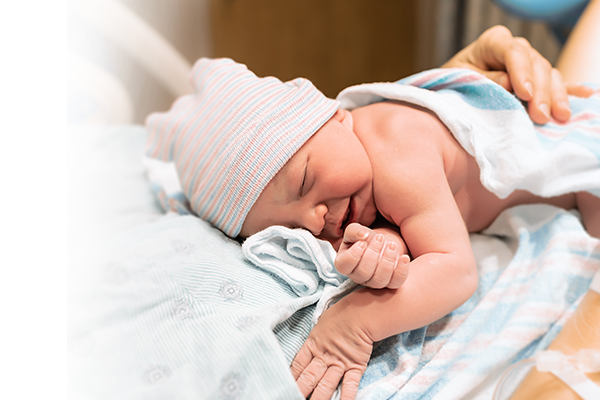The onset of labor is considered to be the occurrence of regular contraction activity, which leads to the shortening and dilation of the cervix. Childbirth is induced by doctors when completing the pregnancy before the spontaneous onset of labor is more beneficial to the mother and the baby. When does this happen? What is preinduction and induction of labor? You will learn about it in this article!
Induction versus preinduction of labor
Induction of labor is one of the most common procedures in obstetrics. As many as 20% of births in the developed world begin with induction. However, for it to have the expected effect of initiating labor, the maturity of the cervix is essential. If this is not the case, labor preinduction is additionally necessary before induction.
In uncomplicated singleton pregnancies, according to PTGiP recommendations, induction of labor at 41 is justified. Week of pregnancy (between 41st + 0. and 41st + 6 weeks). Sometimes it happens that it is carried out earlier. What methods of preinduction and induction of labor are used and what are the contraindications? You can find out about it by reading on.
What is labor preinduction?
Evaluation of cervical maturity is performed using the Bishop scale, which is the most reliable indicator of the likelihood of success (or lack thereof) of labor induction. The parameters considered then are:
- dilation (cm),
- shortening (%),
- The position of the leading point in cm in relation to the inter-spike line,
- consistency,
- The relationship to the vaginal axis.
The cervix is ready for delivery only with a score of 9. In a situation where this organ does not obtain such a number, preinduction of labor, that is, pharmacological or mechanical stimulation of the maturity of this organ, is carried out.
Methods of preinducing labor
Mechanical methods of preinduction include the Foley catheter, which is often referred to as a balloon. Foley catheter, accelerates labor in two ways. The first is direct stretching of the cervix, while the second is an increase in the local secretion of prostaglandins, which are responsible for uterine contractions. Once inserted and filled with saline, the catheter is usually left in place for 24 hours. Among pharmacological methods, the most common is prostaglandin administered vaginally , which has a spasmodic effect on the uterine muscle.
What is induction of labor?
Induction of labor is defined as the artificial stimulation of the mechanisms that start labor before its spontaneous on set. The goal of this procedure is to bring about the dissolution and delivery of the baby with the placenta. The World Health Organization (WHO) once issued a recommendation that read as follows:
“Births should not be induced for convenience. In any geographic area, the percentage of such births should not exceed 10%.” – (WHO 1985r).
The organization 25 years later, in a 2011 document, stated that in highly developed countries, more than 25% of deliveries in a term pregnancy are initiated by induction, This is living proof that it is increasingly being adapted to the established hospital framework, the needs of the staff and, above all, the requirements of moms-to-be. This is because it is sometimes performed at the request of women, when they express a desire to give birth at a given date or when they claim that their pregnancy is prolonged. Although this rarely happens, the claim that induction materializes only for medical reasons is not supported by current statistics.
Methods of inducing labor
This procedure can be carried out in two ways:
Mechanical:
- Separation of the lower pole of the fetal bladder from the uterine walls, which accelerates the onset of labor, through the local release of prostaglandins;
- Interruption of fetal membranes (amniotomy).
Pharmacological
- is most often based on the intravenous administration by drip infusion of an agent called oxytocin.
- The effectiveness of the aforementioned techniques depends on a number of factors, such as gestational age, fertility and a woman’s BMI.
Indications for induction of labor
One of the reasons for inducing labor is post-term pregnancy. In this case, the induction is carried out in 41. One week of pregnancy. According to current medical knowledge, doctors reach for the induction of labor procedure in other situations as well. We are talking specifically about circumstances in which the continuation of the pregnancy could pose a potential threat to the health and life of the mother-to-be and her child.
- Premature rupture of the fetal bladder after the 37th week of pregnancy – this reduces the risk of maternal and neonatal complications.
- Intrauterine fetal growth retardation(hypotrophy).
- Pregnancy complicated by hypertension – due to the increased risk of possible complications in the mother.
- Age of the woman – for women 40 years of age and older who have an uncomplicated pregnancy, induction of labor after 39 weeks is recommended because of the increased risk of maternal and fetal complications.
- Serological Confit.
- Cholestasis of pregnancy – the timing of induction should depend on the current concentration of bile acids.
- Pregnancy complicated by diabetes.
Induction of labor – contraindications
To qualify a pregnant woman for induction of labor, the gynecologist must verify that there are no contraindications to the procedure, as well as perform an OCG and ultrasound. Induction of labor is waived in the case of:
- Placenta or progenitor vessels,
- past operations on the uterine corpus,
- A history of intrapartum uterine rupture,
- Invasive cervical cancer,
- Active genital herpes infection,
- abnormal fetal position (i.e., transverse, pelvic);
- The risk of shoulder dystocia,
- birth disproportionality,
- damage to the anal sphincter during a previous delivery.
Labor induction procedure – complications
Like virtually all medical procedures, induction of labor carries all sorts of potential complications. For this reason, it is very important for medical personnel to monitor fetal well-being and other parameters during induction of labor. During induction can occur, among other things. For hyperstimulation of contractile function, which can lead to fetal cardiac dysfunction. Possible complications also include genital tract bleeding, green amniotic fluid, intrauterine infection or postpartum hemorrhage.
Induction of labor versus cord blood collection
The induction of labor is not a contraindication to cord blood collection, nor is the termination of labor by cesarean section. Only in cases where the life of the mother or the baby is in danger can medical personnel waive the collection. However, such a situation is very rare. Diseases complicating the course of pregnancy that are an indication for induction of labor, such as gestational cholestasis and hypertension, for example, are also not a contraindication to storing the baby’s stem cells.
Natural methods of inducing labor – are they safe?
Home induction methods can be helpful and are eagerly used by women who want to avoid medical intervention. What, on the other hand, do specialists think about this subject? In 2008, researchers at Ohio State University, led by Professor Jonathan Schaffir, conducted a study on pregnant women who had been pregnant for more than 37 weeks. As it turns out, of the 201 women surveyed, 50.7% used natural methods to induce labor, and their babies were born healthy. Thus, they are not harmful, although it is always necessary to inform the attending physician about them beforehand.
FAQ:
- What is inducing labor?
This process is designed to induce artificial uterine contraction activity. Induction of labor should be considered by any woman who qualifies for this procedure, among others. By premature rupture of the fetal membranes. However, it is worth remembering that it can lead to possible complications, such as damage to the cervix.
- How long does it take to induce labor?
The duration of induced labor depends on certain factors, such as. Cervical maturity. Nevertheless, it is worth knowing that the solution by means of induction can take place from several to even several hours.
- What methods of inducing labor do we distinguish?
There are two medical techniques for this procedure, namely – pharmacological induction and mechanical induction. Pharmacological methods of inducing labor involve the administration of intravenous oxytocin. Mechanical induction, on the other hand, is usually based on the separation of the fetal bladder from the uterine walls.
Rate this article:










